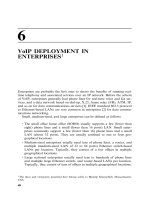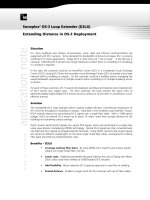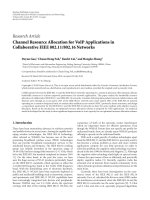VoIP Deployment in Enterprises
Bạn đang xem bản rút gọn của tài liệu. Xem và tải ngay bản đầy đủ của tài liệu tại đây (1.11 MB, 25 trang )
6
VoIP DEPLOYMENT IN
ENTERPRISES1
Enterprises are probably the first ones to derive the benefits of running real-
time telephony and associated services over an IP network. Before the advent
of VoIP, enterprises generally had phone lines for real-time voice and fax ser-
vices, and a data network based on dial-up, X.25, frame relay (FR), ATM, IP,
and so on for data communications services [1]. IEEE standard 802.3 protocol
or Ethernet-based LANs are very common in enterprises [2] for data commu-
nications networking.
Small, medium-sized, and large enterprises can be defined as follows:
The small o‰ce home o‰ce (SOHO) usually supports a few (fewer than
eight) phone lines and a small (fewer than 16 ports) LAN. Small enter-
prises commonly support a few (fewer than 16) phone lines and a small
LAN (about 32 ports). They are usually confined to one to four geo-
graphical locations.
Medium-sized enterprises usually need tens of phone lines, a router, and
multiple (medium-sized LAN of 32 to 64 ports) Ethernet switch-based
LANs per location. Typically, they consist of a few o‰ces in multiple
geographical locations.
Large national enterprises usually need tens to hundreds of phone lines
and multiple large Ethernet switch- and router-based LANs per location.
Typically, they consist of tens of o‰ces in multiple geographical locations.
68
1 The ideas and viewpoints presented here belong solely to Bhumip Khasnabish, Massachusetts,
USA.
The introduction of VoIP in enterprises not only leads to convergence
of multiple disparate networks in one physical infrastructure running only one
(i.e., IP) protocol, it also opens up the network for delivering several new and
emerging productivity-enhancing IP-based applications and services to the em-
ployees and customers of the enterprises. These new services include IP-based
fax and conferencing services, unified messaging, find-me/follow-me services,
Web-based call/contact centers, e-commerce and customer-care services,
support of virtual or remote or tele-workers, and so on.
Although the operational and infrastructure cost savings are the prime
motivations for incorporating VoIP services in enterprises, there are other fac-
tors that contribute equally to the decision. Some of these are (a) use of a uni-
form (i.e., IP only) service and network management platform throughout
the corporation, (b) flexibility in service creation and maintenance using a Web
interface, for example, and (c) simplicity in adding, moving, and changing the
management of desktops/terminals within the corporation. In addition, it is
often said that in medium-sized and large corporations, the investment in VoIP
pays for itself within months (see, e.g., the case studies in the website at www.
von.com, 2001).
The corporate IP network or the Intranet must be properly engineered so
that it meets or exceeds the packet transmission delay jitter, packet loss, and
packet transmission delay limits suggested in Chapter 4 and Appendix C. This
will ensure the required level of quality, reliability, and availability of the VoIP
service anywhere within the enterprise.
This chapter briefly discusses the required network endpoints, interfaces,
and network elements for deploying VoIP in enterprises. It also presents some
networking scenarios that can help corporations to migrate from o¤ering
traditional circuit switch-based telephony (e.g., centrex, PBX) services to its
employees to delivering IP- and VoIP-based advanced and integrated commu-
nications services to its customers (for e-commerce applications) and employees
alike.
IP-BASED ENDPOINTS: DESKTOP AND CONFERENCE PHONES
IP phones are POTS or ISDN phone-like devices based on PCs, intelligent
digital signal processors (DSPs), and real-time operating and networking
software/systems. These devices are used for accessing real-time voice com-
munications services from, for example, any communications application ser-
vice provider (CASP) and for transporting real-time voice signals over the
IP-based packet communication networks. Although the first-generation IP
phones supported only G.711-based voice coding and proprietary or H.323- or
MGCP-based signaling and call control, the emerging IP phones are support-
ing G.729-, G.726-, and G.723-based coding options, and are predominantly
using the SIP protocol for call control and signaling. Many IP phones have
built-in multiport Ethernet hubs to support seamless connectivity to LANs, and
IP-BASED ENDPOINTS: DESKTOP AND CONFERENCE PHONES
69
are also capable of deriving electric power using the same Ethernet cable (a
category 5 cable) that they use for connecting to the Ethernet LAN hub/switch.
Table 6-1 presents a list of features and functionalities that are commonly
available in IP and SIP phones. It appears that these phones are capable of
supporting many of the productivity-enhancing features and functions that are
commonly used in the business communications environment. Also, since IP
phones facilitate dynamic registration of clients (or endpoints) via the dynamic
TABLE 6-1 Typical Features and Functionalities of IP and SIP Phones
Direct dialing based on digit Music on hold
Direct dialing based on e-mail address Caller ID blocking
Digit map support Call forward
Private network dialing plan support Anonymous call blocking
Direct inward dialing (DID) Multiple directories
Direct outward dialing Integrated multiport Ethernet
Call forward network DNS service
Do not disturb (DND) Inline power (over category 5 LAN cable)
Conferencing (four or more parties) 10-BaseT and 100-BaseT
Call transfer with consultation Auto-identification (easy add/move/change)
Call transfer without consultation G.711, G.729, and wideband CODECs
Call waiting Intercom support
Speakerphone with mute option Plug and talk feature
Infrared port Register station by using proxy
Adjustable and custom ring tone In-band DTMF transmission
Hearing aid–compatible handset Out-of-band DTMF transmission
Volume control Local or remote call progress tone
Independent volume control Network startup via DCHP
Last number redial Date and time support via NTP
Display contrast control Third-party call control via delayed media
play
Internal phone browser Support for endpoints in SDP
Call log Local directory, conference call log
Call log filter Message waiting indication (MWI)
Customizable display screen Speed dial to voice mail box
Online help General-speed dial
External speaker jack Capability to add new applications
JTAPI support Click to dial from outlook
Call hold Access to application portal
LDAP-based phone book Support of QoS by packet marking
Presence management Call park
Vcard exchange via phone Barge-in calling
Video streaming Intelligent attendant
Scanning/checking e-mail Rolodex-style scroll knob
Display call image Automatic version update (via TFTP or
HTTP)
Embedded Java Ability to view video graphic files
70
VoIP DEPLOYMENT IN ENTERPRISES
host configuration protocol (DHCP) features of IP, they make adding, moving,
and changing very simple. Finally, since IP phones use the same data net-
working infrastructure and technologies, they make enterprise network evolu-
tion and management more seamless and less expensive.
A number of recently developed IP phones support conferencing features
and functions that are commonly available in expensive traditional PBX
phones or in the phones that can only be purchased as part of the key telephone
systems (KTSs). These IP phones o¤er full-duplex audio, display functions,
and features such as access to voice mail and name directories, call add, drop,
and transfer, and interconnecting multiples conferences bridges. In addition,
these conference IP phones can be used as a client to the IP-PBX (described in
the next section) in integrated voice (TDM) and data (mainly IP) networks by
simply plugging them into the LAN, or Ethernet network [1,2] jack in any
conference room in the o‰ce.
Many companies, including Cisco (www.cisco.com, 2001), Pingtel (www.
pingtel.com, 2001), Polycom (www.polycom.com, 2001), and Siemens (www.
siemens.com, 2001), have recently started marketing their desktop and confer-
ence IP phones to high-end residential and enterprise markets.
IP-PBX, IP CENTREX, AND IP-BASED PBX TIE LINES
IP-PBXs are PBX devices that support the following:
a. Various IP telephony and/or VoIP features;
b. Call processing/control and attendant features/functions that are avail-
able from traditional circuit-switched PBXs;
c. One or more of the following types of phones: analog, digital, ISDN-
BRI, IP, and so on; and
d. One or more T1/E1-CAS/PRI links and digital subscriber lines (DSLs)
for connectivity to PSTN switches and IP trunks for local and/or wide
area data/packet networking. The IP trunks can be used to interconnect
the IP-PBXs of a corporation in di¤erent geographical locations over an
IP-based corporate virtual private network (VPN).
Deployment of IP-PBX not only reduces the costs and enhances the features
and capabilities of enterprise communications, it also simplifies the software
upgrading and management of the integrated voice and data infrastructure. In
addition, IP tie lines or IP trunks can be used to interconnect the IP-PBXs in
di¤erent geographical locations. The use of IP tie lines can (a) make the same
advanced call control features of the corporation’s headquarters available
to employees in remote branch locations and (b) allow employees to hold
conference calls over a wide geographic area, avoiding long-distance telephone
charges.
IP-PBX, IP CENTREX, AND IP-BASED PBX TIE LINES
71
IP-PBXs can o¤er the same set of services that traditional analog centrex
and ISDN centrex o¤er. In analog centrex and ISDN centrex, the call control
features and functions reside in the CLASS-5 switch placed in the central o‰ce
(CO) building, with, for example, a dedicated T1 line for every 23 (for T1-PRI)
or 24 (for T1-CAS) telephone terminals on the customer’s premises, as shown
in Figure 6-1a. This system is not only expensive to maintain, it also may o¤er
only a limited and/or proprietary set of centrex features. In PBX (traditional)
or IP-PBX (emerging), these functions are usually hosted in the network ele-
ments that reside on the customer’s premises, and one or more T1 (traditional)
or DSL (emerging) connections to the CO can be used for PSTN connectivity,
as shown in Figure 6-1b. The DSL connections can carry both voice and data
tra‰c over the same link and are usually significantly less expensive to main-
tain than T1 connections. Also, since the call control can be local and IP-PBX
supports Internet connectivity, it is not necessary to have one T1 line for every
23 (for T1-PRI) or 24 (for T1-CAS) telephone terminals on the customer’s
premise (discussed more in the context of Figure 6-3 at the end of this section).
Note that with the advent of VoIP and the ubiquitous availability of IP-
based network connectivity, analog centrex and ISDN centrex are evolving
toward IP-based centrex. To o¤er IP-based centrex services, the service pro-
vider needs to support a high-quality (i.e., with guaranteed QoS) broadband
(over DSL, T1, Ethernet, etc.) IP link to the customer’s site, instead of o¤er-
ing expensive T1 lines that support voice calls only. The customer can use the
Figure 6-1a Traditional centrex-based telephone service o¤ering to enterprise or cor-
porate customers.
72
VoIP DEPLOYMENT IN ENTERPRISES
broadband IP link for simultaneous transmission of voice and data tra‰c to
deliver a variety of enhanced applications and services to employees. To sup-
port legacy telephones and fax machines, customers need an IP-PSTN GW on
the premises. This GW provides signaling and media (bearer tra‰c) conversion
from the legacy TDM domain on the customer’s premises to the IP domain in
the service provider’s CO. This conversion helps communications with appro-
priate network elements like the IP-PSTN GW, VoIP CC, softswitch, and so
on in the IP network of the service provider. Note that IP PBX and IP centrex
o¤er a superset of the traditional analog centrex and ISDN centrex services,
some of which are shown in Table 6-2 (further details can be found at www.ip-
centrex.org/features/index.html, 2001). Table 6-3 presents typical IP telephony
and VoIP-related features expected from IP centrex and IP PBX. Additional
autoattendant and CC-related features that are expected to be supported by IP-
PBX-like devices are shown in Table 6-4 and discussed in the next section.
When IP-PBXs are used, enterprises can install the IP telephony network
elements or devices adjacent to the data-networking (e.g., LAN) infrastructure,
reducing wiring and management complexity and physical footprint require-
ments [3]. Also, IP-PBX supports not only the flexibility and e‰ciency of IP
telephony, but also peer-to-peer VoIP connectivity over LANs and WANs. In
addition, the IP domain network elements use open (or standards-based) and
Web-based interfaces for call control and feature/service provisioning and
management. Consequently, it is relatively faster and simpler to manage soft-
Figure 6-1b Traditional PBX-based telephone service o¤ering to enterprise or corpo-
rate customers.
IP-PBX, IP CENTREX, AND IP-BASED PBX TIE LINES
73
ware upgrading and to roll out new service features (e.g., unified messaging,
find-me/follow-me services) across the enterprise.
Both traditional PBX vendors and Internet router manufacturers are devel-
oping and marketing IP-PBX and other relevant feature GWs and application
servers. Some of them are Avaya (www.avaya.com, 2001; formerly a part of
Lucent), Nortel (www.nortelnetworks.com, 2001), Siemens (www.siemens.com,
2001), NEC (www.nec.com, 2001), Mitel (www.mitel.com, 2001), and Cisco
(www.cisco.com, 2001). Note that some of the commercially available IP-PBXs
can support many new and emerging services in addition to tens of call pro-
cessing features and functions that are available in traditional circuit-switch-
based PBXs.
Figure 6-2 shows possible architectures for migration of traditional centrex
services to IP-based centerx services with minimal infrastructure investment by
customer but a somewhat significant (less for ISPs but perhaps more for tele-
coms) capital investment from the service provider. Details of the costs depend
on interface and service requirements, scope of the deployment, age of the
equipment (handsets) and the IP network infrastructure already in place, and
so on, and can be evaluated on a case-by-case basis. IP centrex customers can
add new endpoints (phones) without requiring new phone lines to the telecom
service provider’s central o‰ce, and also can roll out many new and advanced
IP-based services in a customized fashion just by adding new servers to their
local IP network (LAN or Intranet). Many existing telecom switch manu-
facturing vendors are developing either (a) line cards that integrate with exist-
TABLE 6-2 Typical Call Control Features and Functionalities of Traditional Centrex
and PBX
Automatic call-back
(Camp on)
Intercom Message- and/or music-
on-hold
Bridged call appearance Last number redial Free seating
Call forwarding (internal
and external)
Message waiting (using light
and/or tone) indication
Time-of-day (e.g.,
night)–based service
Call pickup Multiple call appearance System speed dialing
Caller ID display and
called ID blocking
Mute Voice mail
Hunt groups One-button speed dial Call trace
Distinctive ringing Call transfer Call park
Call drop Volume control Call conferencing
Call hold and waiting Automatic alternate routing Do not disturb (DND)
Auto redial and auto call
back
Automatic route selection
(for outside or 6þ,7þ,
8þ,9þ, etc. calls) and
auto-direct connect
Interactive voice re-
sponse (IVR)–based
service and recorded
announcements
700/900 call blocking Call screening and blocking Emergency call attendant
Call join, fork, stack, etc. Automatic detection of fax
tone
Call intercept treatment
74
VoIP DEPLOYMENT IN ENTERPRISES
ing devices to support the required interfaces and functions or (b) GW devices
to support feature and service interaction and transport mediation between IP
and PSTN domain networking and service delivery elements.
Figure 6-3 demonstrates how an existing circuit switch-based PBX infra-
structure can be migrated to an IP-PBX-based one by adding an embedded
VoIP CC and GW (to PSTN) line card in the existing PBX. Another option
for such a migration would be to use a separate physical device that functions
as an integrated VoIP GW and call controller or proxy of a separate CC,
depending on the system architecture.
Although there are a number of protocols (H.323, SIP, MGCP, etc., as dis-
cussed in Chapter 3) for controlling IP-based endpoints (e.g., a phone), it
appears that because of its openness and simplicity, IETF’s SIP is enjoying
TABLE 6-3 Typical VoIP and Related Features and Functionalities Expected from
IP-PBX and IP-Centrex
Simultaneous support
of IP and POTS
(analog, digital,
ISDN-BRI) phones
Support of VoIP for both ac-
cess (IP phones) and trans-
port (inter-PBX IP trunk)
for toll bypass
Support of a large num-
ber (tens, hundreds,
thousands) of IP
phones
Support of self- and
Web-based configu-
ration, provisioning,
user profile manage-
ment, and so on for
easy add/move/
change, find-me/
follow-me, and other
services
Support of the line-card-based
(or integrated) VoIP GW
Support of QoS in both
access and transport
domains by using
access control and
by marking the VoIP
packets as high-priority
packets
Support of the existing
and emerging VoIP
signaling and call
control protocols
(e.g., H.323, MGCP,
SIP)
Support of a wide variety of
voice compression schemes
(e.g., G.711, G.729, G.723)
with and/or without silence
suppression
Support of electronic
numbering (IETF’s
ENUM, RFC 2915/
16) to enable dial using
the e-mail address,
URI, URL, and so on
Support of automatic
fallback to PSTN
trunks for call rout-
ing when the IP
link(s) are congested
Support of unified messaging
including real-time and
store-and-forward fax
transmission service
Support of security, scal-
ability, reliability, and
emergency call routing
Support of IP-VPN and
voice-VPN services
Support of instant messaging,
meet-me/follow-me con-
ferencing (audio and video),
and so on
Virtual enterprise, inte-
gration with e-mail
(MS-Outlook, MS-
Exchange, Lotus
Notes, etc.), presence
management, and so on
IP-PBX, IP CENTREX, AND IP-BASED PBX TIE LINES
75
TABLE 6-4 System Features and Functionalities Expected to Be Supported by an
IP-PBX
Automatic call distribution
(ACD)–based call control
(including priority queueing)
Display of call duration
and distribution
Call and call transfer
between seats
(positions)
Attendant override or barge-in
(including automatic station
relocation)
Supervision and mon-
itoring of calls
Direct inward and
outward dialing
Call display and ANI/DNIS-
based service
Recalling a call Call detail recording
(CDR)
Route and trunk group
selection (automatic or
manual)
Support of computer and
telephony integration
(CTI)
Emergency access
and night service
Fax mail (single or group,
internal or external, etc.)
Programmable toll
restrictions
Voice mail and/or
video mail–based
call back
Priority and serial calling Station hunting
Figure 6-2 Evolution of a traditional centrex service o¤ering to IP and technologies-
based centrex service delivery. The connections shown by the dashed line are required
when PSTN call and feature control reside in the PSTN network, and (a) SS7 SG, call
and MGC, and (b) advanced feature server are not deployed. The centrex feature GW
supports the GR-303/TR-008 interface to the PSTN and may contain the VoIP CC and
MG.
76
VoIP DEPLOYMENT IN ENTERPRISES
significantly more support from both standardization organizations and vendor
communities. And for controlling the VoIP GW devices from the CC (or call
manager or call server), the MGCP and Megaco/H.248 (discussed in Chapter
3) protocols are becoming clear winners.
IP-VPN AND VoIP FOR TELE-WORKERS
VPNs use leased telecommunications links or shared Internet trunks to provide
point-to-point private logical channels for data and/or voice communications.
The flexibility and ubiquity of IP have motivated many Internet and telecom
equipment manufacturers to develop IP-based virtual private networking (IP-
VPN) devices that can support integrated real-time voice (using VoIP) and
data services over broadband IP links. The broadband IP link—shown in Fig-
ure 6-4—could be a digital subscriber line (DSL), a cable modem-attached
CATV line, a wireless or Ethernet local loop or IP over asynchronous transfer
Figure 6-3 IP-PBX-based telephone service o¤ering to enterprise or corporate cus-
tomers.
IP-VPN AND VoIP FOR TELE-WORKERS
77









